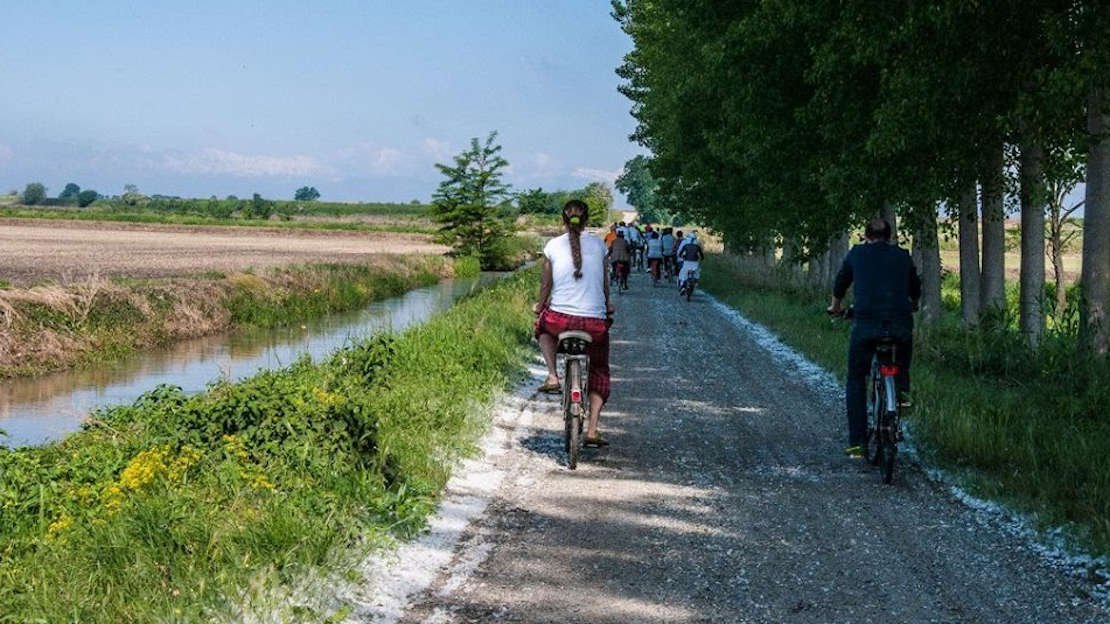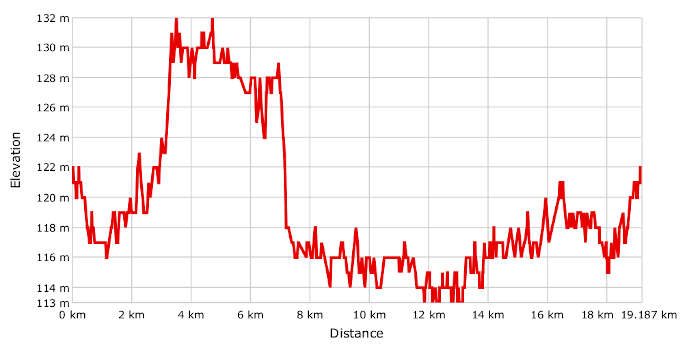
- Bike: strada/trekking
- Difficulty: *
- Distance: 19 km
- Altitude difference: 19 m
- Total ascent: 58 m
- Total descent: 58 m

The place name Balzola derives from the Latin Balteum, which may in turn come from the balze or rocky banks of the Po, which bear witness to the changes the river has wrought on the land. Slow erosion has made the surrounding hills retreat from the water, leaving the rocks in their wake.
But the waters never left Balzola, in contrast to the flowing waters of the Po: the town is surrounded by wet rice fields that stretch out to Vercelli.
Balzola is now one of the undisputed capitals of rice growing in Monferrato. It would be remiss therefore not to suggest a quick and easy bike ride over the rice tracks, in search of some of the area's most important old farms.
Rice farming has shaped the landscape here profoundly and plays host to a great wealth of nature. There is a rich bird life in this area, an ideal habitat for nesting and hunting. The cries of frogs still fill the summer night air, while the canals, springs and reservoirs brim with dragonflies and other insects of the water.
Local character on the rice plains is provided by its herons and egrets, which you can watch as they seek their prey in the water or congregate in their noisy colonies in the trees. These heronries are home to the nests of various species; grey herons, little egrets and cattle egrets are present throughout the year, while squacco and black-crowned night herons show up in spring. The rice fields are also the precious preserve of many duck and wader species, among them mallards, black-winged stilts and ruffs, which stop off here on migration or stay to nest.
The farms you will visit conceal rich histories in their private courtyards, which are the true emblem of the local rice culture. Their buildings are strongly influenced by Roman villas and the cloisters of Cistercian abbeys. More properly called granges in their local context, they are made up of buildings on four sides of a great yard. They were the centre of farming in days gone by and could be home to thirty or more families, although their occupants would double or triple in the rice-growing season. Given how many people lived on them, some contained churches and cemeteries. It is here that you will find the rice growers' lodgings, and the stalls of the horses and oxen with which they farmed. Many of these farms now lie abandoned, but we recommend visiting four that are still there, namely Cascina Nuova, Cascina Santa Clotilde, Cascina Cortina and Cascina Martinetta.
Start in Balzola, in Piazza del Municipio, where you can fill up your water bottle at the fountain. There is also a hut dispensing still and sparkling water in nearby Piazza Caduti di Nassiriya. Head off north, passing the church of San Michele. Carry on down Corso Matteotti until the cemetery. Pass on the left, where a track begins taking you into the 'chequered sea'. This is classic rice country, where the flat farmland is interrupted only by the odd cluster of buildings.
The road continues on the flat until you come to a crossroads. Go left and you'll come upon Cascina Nuova, with its little church and prominent bell tower. Among the rice fields you'll have no trouble spotting little egrets, snipe, grey herons, lapwings, moorhens and, with a bit of luck, a charming pheasant or two.
It is a place of total tranquillity, where the only noise is that of the water murmuring in the ditches, apart from the occasional tractor at work far off.
Carry on north and you'll soon make out the silhouette of Cascina San Grato, also known as La Fola. It sits behind a hillock, La Costa, which takes no effort to get up on a bike.
At the top of it, turn right in the direction of Rive, a small village that is typical of the Vercelli area. You'll get across it in a few kilometres, passing first the parish church, then the castle (now a private residence).
Take advantage of the few hundred metres of tarmac roads before turning right onto tracks just after the castle, leading south to Balzola.
Reach a crossroad by a small square building, Casot di Sasìn, then turn left for Cascina Santa Clotilde (Valasi), a well-preserved farm with a tower, sitting almost like a little castle among the rice fields. Once you get to the end of the road you'll spy Cascina Cortina and come to a crossroads, where you must turn right. Indulge your curiosity with a glance at the arch on the banks of the Magrelli, one of the main irrigation canals in the area.
Carry on past Cascina Martinetta, which is large and well kept.
The track ends at the SP 25, where you must turn right in the direction of Balzola. As soon as you pass the electrical substation, turn left onto the track for Mulino Bruciato (Mulin Vuleia), which will take you along the banks of a drainage ditch for the Stura canal, in the Prati Avogadri (Prè di Aueri) area.
Once you come to the SP 25, you'll see ahead of you the outline of the village of Balzola, with its two church towers. You passed San Michele already, at the beginning of the route. Coming back into the village now, you will see the parish church of the Assunzione di Maria Vergine. The two castles of Fassati (Castlun) and Grignolio, the latter more recent, also stand out, alongside the towering silos of Riseria Vignola, pride of the area, a rice company at the forefront of its sector both in Italy and abroad. Once you're back in Balzola, you can explore all these landmarks by winding your way through the streets, taking in the house fronts painted by the local artist Bertazzi in the process. Local characters and glimpses of village life are immortalised in these facades.
The route is not remotely difficult, so it is suitable for everyone, especially families with young children. It is mostly over tracks, apart from a few provincial roads with little traffic. It can be done in any month of the year, although the best time is between March and October.
Every month sees the country characterised by different colours: the fields, freshly ploughed and brown in March; the reflection of the blue sky in the rice fields in April; the green of the rice plants in May, June and July; in late August and September, the yellow of the matured rice; the beige hay on the earth when the rice is cut in October.
